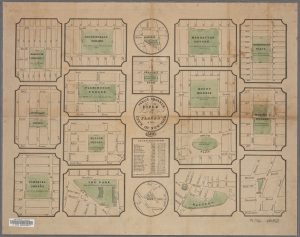 By LANDMARK WEST!
By LANDMARK WEST!
Asking many New Yorkers for directions to Manhattan Square may illicit blank stares, but most Upper West Siders know that it is nestled between West 77th Street and West 81st Streets, and runs from Columbus Avenue to Central Park West. At 17.58 acres, it is better known today as Theodore Roosevelt Park and home to the American Museum of Natural History.
First envisioned in the Commissioner’s Plan of 1811, Manhattan Square was one of the “sundry small places equally the children of necessity.”[1]The others included the Market Place (today, partly occupied by Tompkins Square Park), Bloomingdale Square (53th-57th Streets, and 8th to 9th Avenues), Hamilton Square (66th-68th Streets, and 3rd to 5th Avenues), Observatory Place (89th to 94th Streets, and 4th to 5th Avenues) and Haerlem Square (117th – 121st Streets and 6th to 7th Avenues).
While the need for open space inspired greater calls for parks, by 1838, the City had opened Washington Square, Tompkins Square, and Stuyvesant Square along with Gramercy Park—maneuvers that not only poked holes in the grid but offered a sense of punctuation to the density of buildings. Within these three decades, though, many of the squares called out in the 1811 plan were still unrealized. Once Central Park was begun in 1857 (completed in 1876), some of the squares became redundant, and in reality, only improvement of the “swampy” and “hilly” Manhattan Square was ever actualized—in part because it was mapped as a part of Central Park.
In 1868, Painter William H. Beard proposed a plan for a museum of national prominence. In his vision, visitors would enter a domed pavilion within Central Park and traverse an underground tunnel to the art collections housed in a new structure within Manhattan Square. The painter died the next year, and with him so did his plan for tunnels. In April 1871, the New York State Legislature designated the blocks of Manhattan Square for “both the newly founded Metropolitan Museum of Art and the American Museum of Natural History,”[2] but jostling from Central Park comptroller Andrew Haswell Green saw the former located on the west side of Fifth Avenue—where the Metropolitan Museum of Art currently stands today.
The current occupant, the American Museum of Natural History was first conceived by Albert Smith Bickmore in 1860. The first portions of a Calvert Vaux and Jacob Wrey Mould masterplan were dedicated in 1877 and opened to the general public in 1888. Read more about the museum in our forthcoming history.
Map via New York Public Library
[1] From “Remarks on the Commissioners of the 1811 Plan” signed by Gouv. Morris, Simeon DeWitt and John Rutherford
[2] Stern, Robert A.M., Thomas Mellins, and David Fishman. New York 1880: Architecture and Urbanism in the Gilded Age. New York: Monacelli Press, 1999. P. 168
